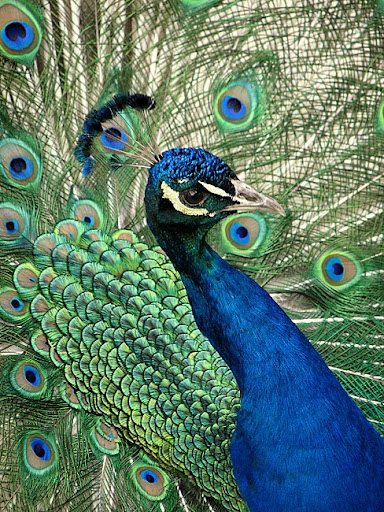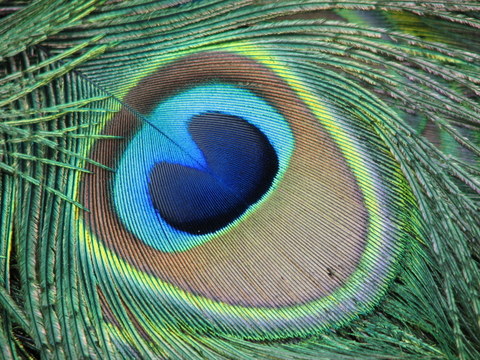
|

Fast Facts: Type: Bird Diet: Omnivore Average lifespan in the wild: 20 years Size: Body, 35 to 50 in (90 to 130 cm); Tail, 5 ft (1.5 m) Weight: 8.75 to 13 lbs (4 to 6 kg) Did you know? A male peafowl is one of the largest flying birds when the combined length of its train and its large wingspan are considered. |

Peacocks are large, colorful pheasants (typically blue and green) known for their iridescent tails. These tail feathers, or coverts, spread out in a distinctive train that is more than 60 percent of the bird’s total body length and boast colorful "eye" markings of blue, gold, red, and other hues. The large train is used in mating rituals and courtship displays. It can be arched into a magnificent fan that reaches across the bird's back and touches the ground on either side. Females are believed to choose their mates according to the size, color, and quality of these outrageous feather trains. | ||||
-National Geographic

Because of its gorgeous appearance, the peacock has long been famous outside of its native countries of Southern Asia and Malaysia, and was kept for centuries by people first in China and then in Europe.
The Phoenicians brought the peacock to Egypt more than three thousand years ago. Historical records indicate that Solomon kept several peacock species, among other pheasants, with the India Blue being his favorite peacock. Peafowl were extensively raised by the Romans for the table as well as for ornamental purposes, and medieval Europe carried on this practice as well. It is only after the XVI Century, when turkeys were imported from Mexico, that the peacock was discarded as a table bird for the more fleshy American birds.
Today, thousands of people all over the world keep and breed peafowl as a hobby or business around their homes or on game bird farms. Many peafowl also live at freedom and breed in parks and gardens.
Peafowl were also considered a delicacy in these cultures for centuries. Fortunately, few of peacock speciesare used for food today, except in some of the more remote and less civilized places where they are found in nature. See the printed magazine for more information on man's long held fascination and cultural aspects of the peacock.
There are but two naturally occuring peacock species, the Indian peafowl Pavo cristatus from India, often called Blue peafowl, and the Green peafowl Pavo muticus which lives farther east in Burma, Thailand, Indo China, Malaya and Java. It is curiously absent from Sumatra and Borneo. The latter peafowl has three subspecies: Spicifer in Western Burma, a duller, bluer race; Imperator in Eastern Burma, Thailand and Indo China, much brighter wid greener: andmuticus in Java, which is still more brilliant. The last two are usually kept in America at present, and probably mixed, but for practical purposes they are just the same, the differences being noticeable only on close examination.
There are many mutations and breeds of peacocks that have been developed and are commonly available from peacock breeders.The India Blue Peacock is commonly kept and bred in captivity by people across America and around the world. They are not expensive and thousands of them are bought and sold each year. They are hearty and easy to keep, even in cold districts. The Green species is not bred as often as the India Blue and is therefore more expensive. You can see that the tail of the green peacock is exceptionally beautiful! The Green is more susceptible to cold and needs to receive adequate protection from the cold.
Peafowl can be quite sociable and often display their feathers right in front of you in the springtime. The male peacock in the spring displays his gorgeous tail feathers and also utters an awakening call which is loud yet quite delight to hear!
Peacock feathers are popularly used in unique crafts and decorations.
You can feed a peacock the same as any other pheasant. The diet provided by many people includes mixed grains, game bird crumbles (such as Mazuri available at many feed stores), and a variety of greens. The birds hardly ever become sick and we have a record of one peacock that lived to be 40 years old!
Peahens are excellent mothers, but peachicks can be reared just as well in a brooder. They are among the easiest birds to raise. One thing to be careful about is to give them good shelters in the autumn and winter following their birth, as they are not fully grown before eight or ten months.
The Indian Blue Peacock has produced several mutations in captivity. These include the Black-shouldered, in which the male has the wings blue, green and black, the female being very pale; the White; and the Pied, in which the normal plumage of the Indian Blue is irregularly marked with white. The so-called 'Spalding' variey is a hybrid between the Indian and the Green species. It is very beautiful bird, intermediate between the two parents in colors, in hardiness and in temperament.
-gamebird.com



Natural History
The earliest history of the peacocks cannot be established, mainly because bird skeletons do not lend themselves well to the process of fossilization. Peacocks are close relatives of pheasants, nearly all of which come from Asia. The Congo peacock is the only species of pheasant that is naturally distributed outside Asia. All peacocks have iridescent plumage with impressive displays, small heads, long necks and strong spurred legs(unusually, the females also carry spurs). Like pheasants, they all roost in trees for safety. Another characteristic they have in common with pheasants is their preference for thick, shady undergrowth where they skulk and are difficult to observe. Consequently, the status of the peacock is largely unknown in the wild. Peacocks are in full plumage from June to December, the peahen laying eggs and nesting during July and August. The long train is discarded entirely in January. Both sexes go through this period of swift moulting, long revovery and then rapid regrowth, though the female carries no train. In the period when they have short feathers, the males appear to be depressed and seek seclusion. The peacock’s legs, grayish brown with dark claws, are typical gallinaceous or barnfoul like the chicken, sit oddly with the glamour of the rest of the bird. Not many birds have stories about their feet, but the peacock has been accused of being so ashamed of its large legs and feet that when it catches sight of them its stops displaying and cries aloud in protest at having them imposed on it.
The Proud sun-bearing Peacock with his feathers
Walks along, thinking himself a king.
And with his voice prognosticates all weathers,
Although God knows but badly he doth sing;
But when he looks downe to his base-black Feete,
He droopes and is asham’d of things unmeete.
In reality they are powerful aids when escaping, for all peacocks prefer to run into thickets rather than take flight. They can run at speed, outdistancing a pursuing man over a short distance. The spurs are only 2.5 centimeters long but can be uses to slash at another male like fighting-cocks in defence of territory at breeding time. Fights take place with males facing each other, leaping in the air and raking downwards.
The curious gait of the peacock, especially while displaying his train, has led to it being accused of swaggering and strutting. However, the stiff-legged strut and apparent swagger are due merely to the mechanical effort to keep balanced. In a high wind, these movements are correspondingly exaggerated and pecocks are reluctant to display when it is windy. Shakespeare described the strut of the peacock as “a stide and a stand” (Trolius and Cressida III.iii, 253-4)
The peacock’s call, said to resemble paaaavoo (pavo – latin for peacock) is described as being harsh, strident, screeching and unpleasant. The peacock can almost seem mute, due to the brevity of its calls over time. Some do not call throughout an entire day. Their call is heard primarily upon attack, or threat. It is a rare and intriguing treat.
Peacocks can live for 20-25 years, breeding from their third year onwards. The female normally lays three to five eggs. The nest is a mere scrape on the ground with a few dry sticks and leaves, hidden away in the shrubs. The chicks run around as soon as they are hatched and take a few weeks to become independent. Male chicks take three years before they have a full train. The birds are at their most spectatcular in the breeding season when the polygamous males spend a good deal of time displaying. The train is full breeding plumage projects from 100 to 120 centimeters (sometimes more) beyond the end of the true tail containing around 100-150 feathers.
There are three species of peacock: blue, green, and Congo. There are three variations of the blue peacock: white, pied, and black-winged. White peacocks are seen in many wild musters, as well as among captive birds. Entirely white birds are not true albinos for they have the normal brown eyes and breed true. The ocelli on the train are barely visable. They are every bit as spectacular and as beautiful as their colored relations. Some birds exhibit their odd white feather amoung their normal plumage, giving a pied effect. The bird may have a white peacock in its ancestry, but no one is quite sure why this occurs.
The green peacock differs from the blue peacock and is easily distinguished from it physically by the cock and hen being brighter and greener in color; in his peculiar facial coloring; the long barbed crest of straight, stiff, narrow feathers; a voice that is not as loud, even less frequently heard, and of a deeper tone; and longer legs. The effect of the display of the green peacock is of a golden-bronze hue. There are three variations of the green peacock similar to that of the blue.
The Congo peacock was discovered in 1937. It is much smaller than the green and blue and bears no train. Unlike the green and blue peacocks, the Congo peacock is monogamous and more vociferous, calling throughout the night.
There are many other species of animals that have now been labeled as peacock, ranging from insects such as butterfly, to fish, and to flowers. There is even a constellation in the sky called Pavo; and its largest star, 183 light years away, is called Peacock.
this is amazing now i want a white peacock
ReplyDeleteHey ,
ReplyDeleteYou ahve used one of my pictures in this post .Please give due credit for the photographers who own the pictures .
Ratish
http://photography.ratishnaroor.com
beautiful and very informative. thank you for posting
ReplyDelete